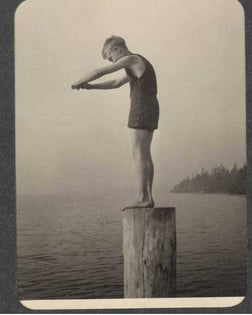
And what if we couldn't make ideas with our bodies?
Body of Ideas
Arts-based Workshop about Bodily Metaphors
Location:
Haihatus Residency, Joutsa, Finland
Date:
29 February 2024
Arts-based workshop about bodily metaphors, their perceptual self-evidence, source for creative inspiration, and collaboration. The following page is both a description, and a documentation of the very first edition of “Body of Ideas” that took place at Haihatus Art Center, Joutsa (Finland) in February 2024. The workshop is a starting point my ongoing artistic research investigating notions of intelligence: How can the embodied mind become an explicit source of inspiration, and therefore for a source for the knowledge about a very specific kind of intelligence?


The first edition kept a literal form of a workshop consisting of five phases: arriving, listening, collecting, shaping, rearranging and reflecting as they have been proposed by Gabriele Klein et al. in their “Choreographic Toolkit”.
I am generally interested in the human body as a vessel of/for knowledge. For this workshop, the research and writing of philosopher Mark Johnson and linguist George Lakoff set the entry point to this exploration from and with metaphors in the human language. The consituting aspects of these metaphors, the as so called primary metaphors, and image-schemas are the central investigative content of the workshop which translate, and transpose from one phase to another.


As a creative investigation, the aim was to play with conceptual metaphors that humans seemingly use without knowing or realizing that they are grounded in the experience of being (in) a human body with the aforementioned sensorymotor and motion systems. Participants, regardless of their background and sensitivity to the bodie’s capabilities, were introduced to Laban’s system of body parameters by an improvisational warmup and reminded of their (bodies’) senses, including balance and proprioception, through decoration objects in the room, and collective sharing.
Throughout the workshop, participants are invited to investigate preselected primary conceptual metaphors, such as “Affection is warmth”, “Knowing is seeing” or “Purposes are destinations” through the lens of the bodie’s somatosensory and perceptual motor system. How does “Knowing is seeing” become recognizable through the bodie’s senses, its awareness of itself in space, its capacity to balance, or to grasp an object, to walk, crawl, or move and select trajectories accordingly?
With these parameters in their hands, groups of two played, discussed, and created with the primary metaphor they had been assigned to. The results, be they a spoken reflection, a movement or theatre improvisation, or a written text, was up to the participants. The only rule was to create something in the frame of the workshop that would be shared with other participants. Then, the created material from the duo setting became imrpovisational material for the whole group, a mix of a dance and movement parkour allowing the material from earlier to stay with everyone for the duration of a set time. In the closing, participants shared their insights and learnings.
Those insights inform the next steps I wish to take with this format.